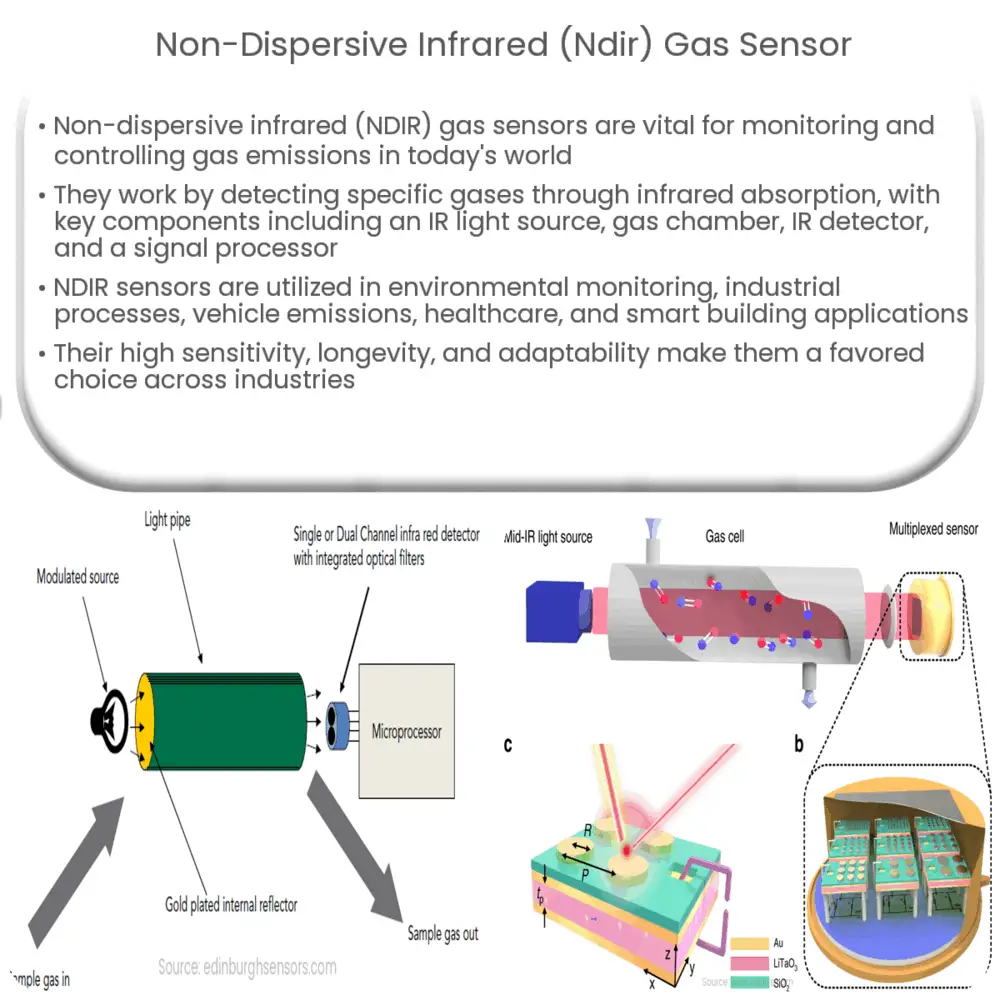NDIR gas sensors use infrared absorption to detect specific gases, offering high sensitivity, selectivity, and stability across various applications.

Non-Dispersive Infrared (NDIR) Gas Sensors: A Comprehensive Guide
In the modern world, monitoring and controlling gas emissions have become a necessity to ensure a healthy and safe environment. Non-dispersive infrared (NDIR) gas sensors have emerged as one of the most reliable and widely-used sensing technologies in recent years. In this comprehensive guide, we will explore the working principle, applications, and advantages of NDIR gas sensors.
Understanding the Basics of NDIR Gas Sensors
Non-dispersive infrared (NDIR) gas sensors are a type of optical gas sensor that utilizes the principle of infrared (IR) absorption to detect and measure the concentration of specific gases in the air. These sensors primarily consist of an IR light source, a gas sample chamber, an IR detector, and a signal processing unit. The gas to be measured is exposed to the IR light, and the amount of light absorbed is used to determine the concentration of the gas in the sample chamber.
Working Principle of NDIR Gas Sensors
The working principle of NDIR gas sensors is based on the absorption of infrared radiation by certain gas molecules. When the IR light passes through the gas sample chamber, the gas molecules selectively absorb specific wavelengths of the light. This absorption causes a reduction in the intensity of the transmitted light, which is then detected by the IR detector. By measuring the change in the intensity of the transmitted light, the concentration of the target gas can be calculated.
The selective absorption of light by gas molecules is governed by their unique vibrational and rotational energy levels. Each gas molecule has a specific set of energy levels that correspond to distinct absorption bands in the IR spectrum. By using an IR light source with a wavelength that matches the absorption band of the target gas, NDIR gas sensors can selectively detect the presence of specific gases in the air, even in the presence of other gases.
Key Components of NDIR Gas Sensors
NDIR gas sensors typically consist of four main components:
- IR Light Source: This component generates the IR radiation that is used to probe the gas sample. Common light sources include incandescent lamps and IR light-emitting diodes (LEDs).
- Gas Sample Chamber: This component holds the gas sample and allows the IR light to pass through it. The chamber can be designed in various configurations, such as flow-through or static, depending on the application requirements.
- IR Detector: This component measures the intensity of the transmitted IR light after it has passed through the gas sample. Common types of IR detectors include thermopiles and pyroelectric detectors.
- Signal Processing Unit: This component processes the signal from the IR detector and converts it into a readable output, such as a voltage or digital signal, that can be used to determine the concentration of the target gas.
Applications of NDIR Gas Sensors
NDIR gas sensors have a wide range of applications across various industries and sectors. Some of the most common uses include:
- Environmental Monitoring: NDIR sensors are widely used for monitoring air quality and detecting greenhouse gas emissions, such as carbon dioxide (CO2) and methane (CH4), to help combat climate change and ensure a cleaner environment.
- Industrial Process Control: In industries such as petrochemical, power generation, and manufacturing, NDIR sensors are used to monitor and control gas emissions, ensuring worker safety and regulatory compliance.
- Automotive Emissions Monitoring: NDIR sensors can be integrated into vehicle exhaust systems to monitor emissions and improve fuel efficiency, helping to reduce the overall environmental impact of transportation.
- Medical Applications: In healthcare settings, NDIR sensors are used for monitoring respiratory gases, such as CO2, to ensure patient safety and effective treatment during surgeries and other medical procedures.
- Smart Buildings and HVAC: NDIR sensors can be used to monitor and control indoor air quality and ventilation in buildings, improving energy efficiency and occupant comfort.
Advantages of NDIR Gas Sensors
There are several advantages to using NDIR gas sensors, which contribute to their popularity and widespread use:
- High Sensitivity and Selectivity: NDIR sensors can detect specific gases at low concentrations, even in the presence of other gases, providing accurate and reliable measurements.
- Long-term Stability: The performance of NDIR sensors remains stable over time, with minimal drift and calibration requirements, making them suitable for long-term monitoring applications.
- Low Maintenance: NDIR sensors have no consumable parts and require minimal maintenance, reducing operational costs and downtime.
- Resistance to Contaminants: NDIR sensors are less affected by contaminants and interfering gases, providing accurate measurements even in harsh environments.
- Wide Range of Applications: Due to their versatility and adaptability, NDIR sensors can be used in various industries and applications, as mentioned earlier in this article.
Conclusion
Non-dispersive infrared (NDIR) gas sensors have become an essential tool in various applications, from environmental monitoring to industrial process control. Their ability to provide reliable, accurate, and selective measurements with low maintenance and long-term stability makes them a popular choice among various industries. As technology continues to advance, NDIR sensors are expected to play an even more significant role in ensuring a safer and cleaner environment for everyone.



